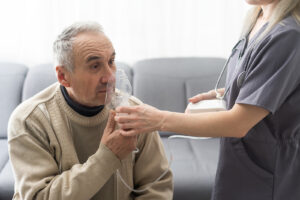Home Health Care Facts About COPD

COPD: Home Health Care Herendon VA
Chronic Obstructive Pulmonary Disease, or COPD, is a lung disease that gets worse over time. It affects millions of people around the world. For seniors, about 10% of those over 75 are dealing with COPD. Home health care providers can help seniors who have COPD monitor their symptoms to assess their need for increased care.
What Is Chronic Obstructive Pulmonary Disease?
Chronic Obstructive Pulmonary Disease is the term used to describe a group of lung diseases such as chronic asthma and emphysema. Understanding COPD starts by knowing what causes it, what its signs are, and how to treat it. COPD is often caused by smoking, but it can also result from exposure to air pollution, secondhand smoke, and workplace dangers like dust and chemicals. Unfortunately, COPD may also happen because of genetics.
One in four patients with COPD have never smoked, which can be frustrating if your loved one is diagnosed with the disease and have difficulty pinpointing a reason. Understanding their history and possible exposure, plus the family’s health history, is key.
What Causes COPD?
Seniors with COPD may have trouble getting enough air, may cough uncontrollably, and may even wheeze. Most of the time, these symptoms are worse in the morning or when they are physically active. This might cause seniors to avoid physical activity, which only leads to more health issues. Over time, seniors may have trouble breathing even when they aren’t physically active.
Treating COPD
The goal of treating COPD is to improve the quality of life and control symptoms. Bronchodilators, which help open up the airways by relaxing the muscles around them, and inhaled corticosteroids, which lower inflammation in the airways, may be used as treatments. Pulmonary therapy, which includes learning how to breathe better and how to do exercises, may also be suggested. In severe cases, seniors may need oxygen treatment or surgery.
Having home health care support helps family caregivers monitor their loved one’s conditions. In addition to the treatments listed above, home health care providers can ensure seniors participate in physical activity throughout the day and eat a healthy diet. They can also work with seniors who might be trying to reduce their exposure to common causes.
When it comes to Chronic Obstructive Pulmonary Disease, prevention is key. The best way to avoid COPD is to not smoke. Staying away from secondhand smoke and other dangers is important too. Seniors who already have COPD can slow the progression of the disease and improve their quality of life by stopping smoking and staying away from things that set it off.
It’s important that seniors understand COPD and how they can strengthen their health by steering clear of situations that might trigger their symptoms. By taking steps to prevent COPD, or maintaining a healthy lifestyle if they already have it, they can improve their quality of life and lower their chance of complications.
If loved ones are struggling with this condition, talk with their home health care provider to see what support can be provided.
